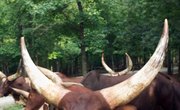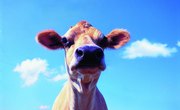
Guernsey cattle get their name from the British island on which the breed originated. Guernsey cows are used primarily in the dairy industry because of their physical traits, rich milk and docile demeanor. However, this breed has begun to fall out of favor partly because of the fat content and golden color of its milk compared to that of other breeds. A Guernsey cow is distinguished physically by its medium-to-large size, fawn coloration and arched horns.
Height and Weight
Guernseys are considered medium-to-large cattle, with cows averaging 1,400 pounds and bulls 2,000 pounds, with a minimum desired weight of 1,200 for dairy cows. They typically measure 54 inches or more in height. With their intermediate size, they produce a high quality, high fat milk, but consume less food per pound of milk compared to large breeds, like the Holstein.
Coloration
In 1883, the Guernsey breed’s coloration was officially determined and has remained unchanged since. A purebred Guernsey is red or fawn in color and may have white markings, or be completely solid red or fawn. The tail and underside often are white, and the Guernsey typically has a cream-colored muzzle and amber feet. Guernsey’s have yellowish inner ears that may be reflective of the richness and golden color of their milk.
Horns
Guernsey cattle typically are horned, and these horns are short and curved in shape. However, some North American Guernseys were developed to be “polled,” which means that they have no horns even though they typically should. Polled Guernseys from America were imported into England in the 1950s.
Comparison to Jersey
Though they have some physical differences, the popular Jersey cattle and Guernsey cattle can be mistaken for each other. Jerseys often are darker in color and have a black nose. The Guernsey typically, though not always, is larger than the Jersey, and the Guernsey produces higher quality beef calves.
Crossbreeding
Some dairy farmers have experimented with crossbreeding purebred Guernseys with black and white Holsteins. The goal of this crossbreeding is to maintain the docile disposition of the Guernsey, while avoiding inbreeding of the Guernseys. The resulting half-Guernsey/half-Holstein cattle, according to farmer Tom Ripley, are strong producers that physically are most similar to pure Holsteins.
References
- English Guernsey Cattle Society: Breed Facts
- The American Livestock Breeds Conservancy: Guernsey Cattle
- The Encyclopedia of Historic and Endangered Livestock and Poultry Breeds, by Janet Vorwald Dohne
- Oklahoma State University Breeds of Livestock: Guernsey
- World Guernsey Cattle Federation: Guernsey Breed History
- Naturally Polled Guernseys, by N. L. Goodland
Writer Bio
E. Anne Hunter has more than a decade of experience in education, with a focus on visual design and instructional technology. She holds a master's degree in education. Hunter has contributed to several professional publications, covering education, design, music and fitness, among other topics.



